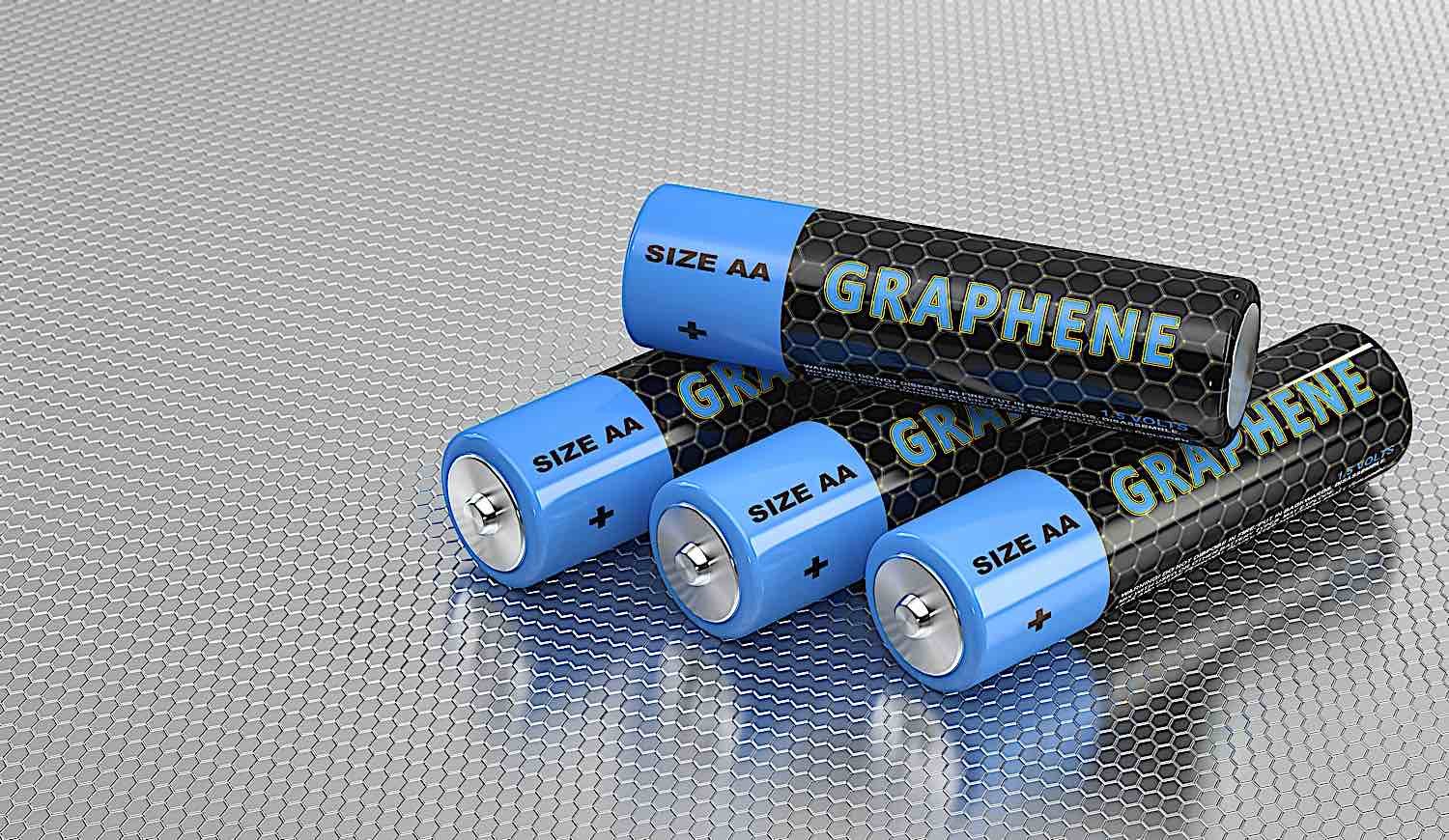Graphene, a groundbreaking material that comprises a single layer of carbon atoms armor-plated into a hexagonal lattice, has the potential to significantly revolutionize the electronics industry — and many other industries as well. What happened to this breakthrough material? Developed back in 2004, it promised to revolutionize the world? What’s taking so long? (If you can’t wait for the answer jump to the bottom of this feature.)
It’s not only two hundred times stronger than Steel, it is a supremely efficient conductor, transparent super thin. The design and engineering applications stagger the conceptual imagination.

“Graphene is the world’s strongest material, and so thin that even a fragile soap bubble can sustain its weight.” – Nature Reviews Materials
Quick Facts
- Graphene is a single layer of carbon atoms arranged in a two-dimensional honeycomb lattice.
- Graphene is the thinnest compound known to man at one atom thick, and also incredibly strong – about 200 times stronger than steel.
- Graphene has a high electron mobility at room temperature, meaning electrons move through it very quickly – faster than any other known material.
- Graphene-based transistors have been developed that are 100 times faster than silicon-based transistors.
- Graphene can be used to create flexible displays for devices like smartphones, tablets, and TVs.
- Graphene can be used to improve the performance of batteries and supercapacitors.
- Graphene has the potential to revolutionize the semiconductor industry, potentially replacing silicon.

200 Times Stronger than Steel; Conducts Electricity Better
Graphene has the potential to turn conventional circuitry on its head due to its outstanding conductivity. Thanks to their high electron mobility, graphene circuits can achieve much higher speeds than traditional ones, thus promising dramatic increases in computing power. (Source)
When it comes to smartphone screens, graphene’s strength and flexibility are its standout features. Being 200 times stronger than steel, yet incredibly thin and flexible, graphene can significantly increase the durability and longevity of phone screens. This also opens the door for more innovative screen designs, like malleable and foldable displays. (Source)

Other potential applications of graphene:
- Batteries: By using graphene, it’s possible to create batteries that recharge incredibly quickly and hold a charge much longer than today’s lithium-ion batteries. (Source)
- Sensors: Graphene could also improve sensor technology. It’s exceptional electrical sensitivity means it could be the key to creating smaller, faster, more efficient sensors. (Source)
- Data Communication: As graphene can be used to create lasers that operate at higher speeds than current technology, it can make data communications significantly faster. (Source)

Fast Statistics
- Graphene is 200 times stronger than steel
- Graphene is the thinnest compound known to man at one atom thickGraphene is the thinnest compound known to man at one atom thick
- Graphene is the best conductor of heat at room temperature
- Graphene conducts electricity better than any other common conductor
- Graphene is nearly transparent, absorbing only 2.3% of light
- Graphene transistors can potentially run at frequencies up to 1000 Ghz
- Graphene batteries can store almost twice as much energy as lithium-ion batteries
- Graphene supercapacitors can charge and discharge a hundred to a thousand times faster than traditional batteries
- Graphene-based solar cells have an efficiency of over 20%
- Graphene supercapacitors can charge and discharge a hundred to a thousand times faster than traditional batteries
- Graphene-based touch screens are more responsive and durable than current technology
This is only the tip of the iceberg. Graphene’s potential extends far beyond current applications, enticing engineers and designers to break conventional enginneered design barriers.

Graphene and its Impact on the Design and Production of Transistors
For industrial designers and electrical engineers, graphene’s properties have sparked significant interest in a specific application: transistors. John Rogers, a material scientist quoted in IEEE Spectrum, describes graphene as a “game changer” for flexible and ultra-high-frequency transistors.
The disruptive technology of graphene is characterized by its exceptional conductivity. It wields an impressive on-off rate of 100 gigahertz, as announced by researchers in 2010. This number is far above the speed of conventional silicon transistors, as reported in Nature.
The exceptional conductivity of graphene-based transistors ensures low electronic low-frequency noise. Such properties put graphene transistors on the map as potential successors to some silicon components. Thus, it’s fair to say that the future holds a significant role for graphene in the electronics industry, as indicated in the Journal of the Royal Society Interface.
This promise is predicated on the inherent attributes of graphene. Transistors made from graphene could be considerably thinner than modern silicon devices, which implies the possibility of designing faster and smaller configurations. It’s a case of shrinking the size but magnifying the performance – something you, as innovators, are always aiming to achieve. This concept is emphasized further in Science Daily.
As a professional in design or engineering, you can harness the transformative potential of graphene to devise greener, more efficient, and high-performing solutions. With graphene, it seems the possibilities are only limited by our imagination.
Why Graphene hasn’t taken over the world — yet.
Breaking Down the Unique Properties of Graphene
Graphene is the “superstar” of material sciences. Characteristically unique and radically distinct, graphene has become a torchbearer in the circuits of innovation.
The first characteristic most people describe is graphene’s incredible strength. In a study by Columbia University, graphene had a tensile strength of 130 gigapascals, which makes it 200 times stronger than structural steel. This inherent robustness grants it a mechanical stability that’s coveted in manufacturing industries.
Graphene also impresses with its surprising flexibility and stretchability; a quality that could drive innovation in flexible electronics. According to a study published in Nature Physics, graphene can stretch up to 25% without damage, offering product designers new possibilities for creating flexible, robust devices.
Graphene is a also a “superstar” in the world of thermal and electrical conductivity. Its thermal conductivity is about 5,000 Watts per Meter per Kelvin, which is 2 times that of diamond. Its electrical conductivity, on the other hand, is 13 times better than that of copper, offering noteworthy advantages in electronics and energy applications.
Moreover, graphene’s unique two-dimensional structure allows it to be nearly transparent, absorbing just 2.3% of reflecting light, while being impermeable to gases. This property sets the stage for the creation of transparent barrier materials and coatings, revolutionizing everything from electronics to food packaging.
Last but not least, holey graphene, type of graphene with nanopores, is recognized for its exceptional semiconducting properties – a crucial factor in the semiconductor industry. As demonstrated in a paper published in Science Advances, holey graphene exhibits enhanced light absorption and increased carrier mobility, offering a significant boost to semiconducting applications.
In conclusion, the extraordinary properties of graphene – its toughness, flexibility, impressive thermal and electrical conductivity, optical transparency, gas impermeability and semiconducting properties – are poised to catalyze a revolution in the field of design and engineering.
The Future of Cooling Devices: Graphene’s Thermal Conductivity
As an engineer or designer, you know the challenges of dealing with heat dissipation in electronic devices. Traditional methods often fall short, leading to overheated devices and shorter lifetimes of electronics. But graphene, with its high thermal conductivity, is set to change the landscape of thermal management in electronics. It may quite possibly redefine how we design cooling mechanisms.
Think of it as the ultimate heat spreader. Graphene’s thermal conductivity is unparalleled – the highest found to date. Its potential as a heat-spreading solution opens new doors in the design of highly efficient cooling devices. Heat sinks or heat dissipation films, typically used to maintain optimal operational temperatures, can now be reimagined using graphene.
Designing with graphene provides a simpler and more effective solution for heat management. For example, your devices could become leaner without compromising on performance; the thinness of graphene means it won’t contribute significant bulk. Furthermore, it’s robust enough to handle the rigors of ongoing operation, making it ideal for high performance, longer-lasting devices.
What’s more, the superior electrical conductivity of graphene adds another layer of versatility for you, as a designer. Its combination of electrical and thermal conductivity is a game-changer in the realm of integrated circuits. Graphene has the potential to be molded into various shapes and dimensions, giving you a range of possibilities in terms of design and function.
The field of cooling devices is ripe for innovation, and graphene is one of the promising materials leading the charge.
Imagine a future where overheating devices are a thing of the past, thanks to graphene. A revolution is on the horizon, and it’s powered by this remarkable material with fantastic heat conductivity and electrical properties. So, for engineers and designers looking to give their electronic devices a cooler future – graphene could just be the material you’ve been waiting for.
The potential of graphene continues to inspire new thinking in its application across the electronics industry. Surely, it’s the material that’ll carry us into the next age of electronics, and we’re only just scratching the surface of its numerous benefits. Are you equipped and ready to ride this wave of innovation with graphene?
Three Reasons Why Graphene Hasn’t Totally Taken Over Materials and Electronics Design ?
Despite the ocean of potential that graphene holds, you are likely asking, “so, why hasn’t graphene become a mainstream solution for engineers and designers despite its many advantages?” There are three main reasons, none of which are insurmountable obstacles.
- Firstly, the manufacturing and integration of graphene into existing technology and manufacturing poses a significant challenge. Graphene is a sensitive material, and creating large, high-quality sheets without defects or impurities remains a tricky affair. The current methods we have for producing graphene—like chemical vapor deposition (CVD)—aren’t apt for large-scale production.
- Secondly, unmodified graphene doesn’t have an energy band gap, a critical requirement for many electronics, particularly digital ones. Without this band gap, graphene can’t stop conducting electricity, making it unsuitable for transistors and the building blocks of most electronic devices. However, scientists have found ways to modify it through band gap engineering, such as creating Graphene Nanoribbons, but these are still under development and not readily available for mainstream use.
- Lastly, although graphene has an exceptional combination of properties—ability to conduct heat and electricity, unmatched strength, and incredible flexibility—the cost of making it available on an industrial scale remains high. Economics matter, and until manufacturers can find a cost-effective method for production, graphene’s use in everyday electronics remains somewhat a concept of the future.
Scientists and researchers and investors worldwide are exploring better ways to manufacture and incorporate graphene into various tech devices. Once these challenges are addressed, the revolution of the electronics industry via graphene will come to fruition. Hold tight; the future is bright.
































